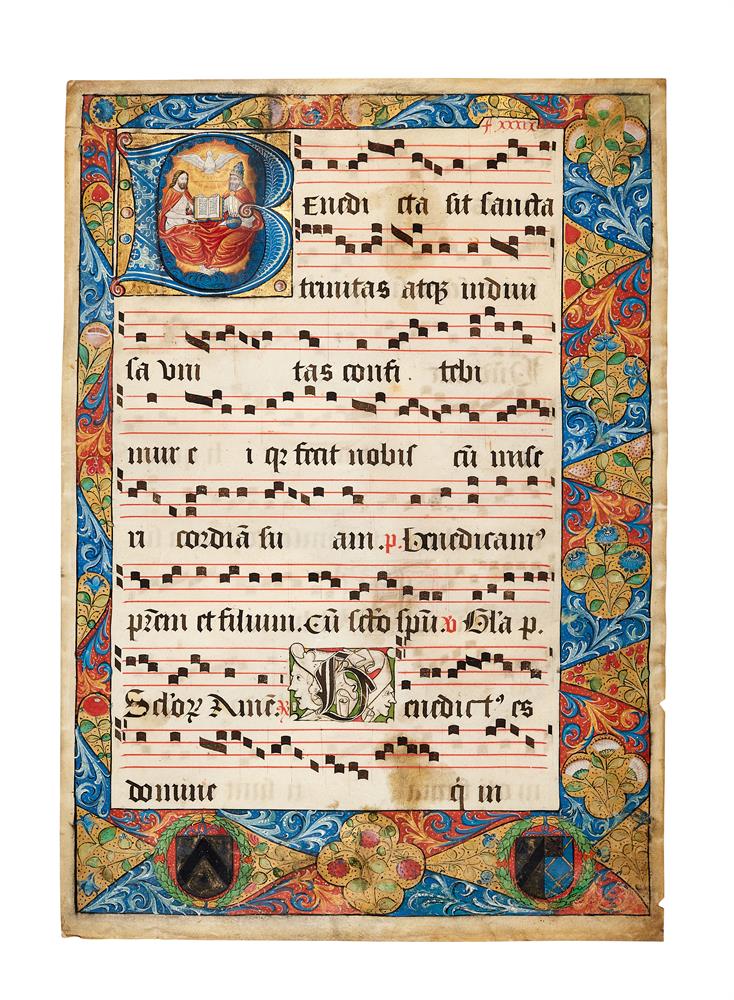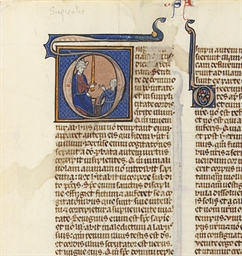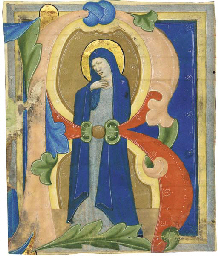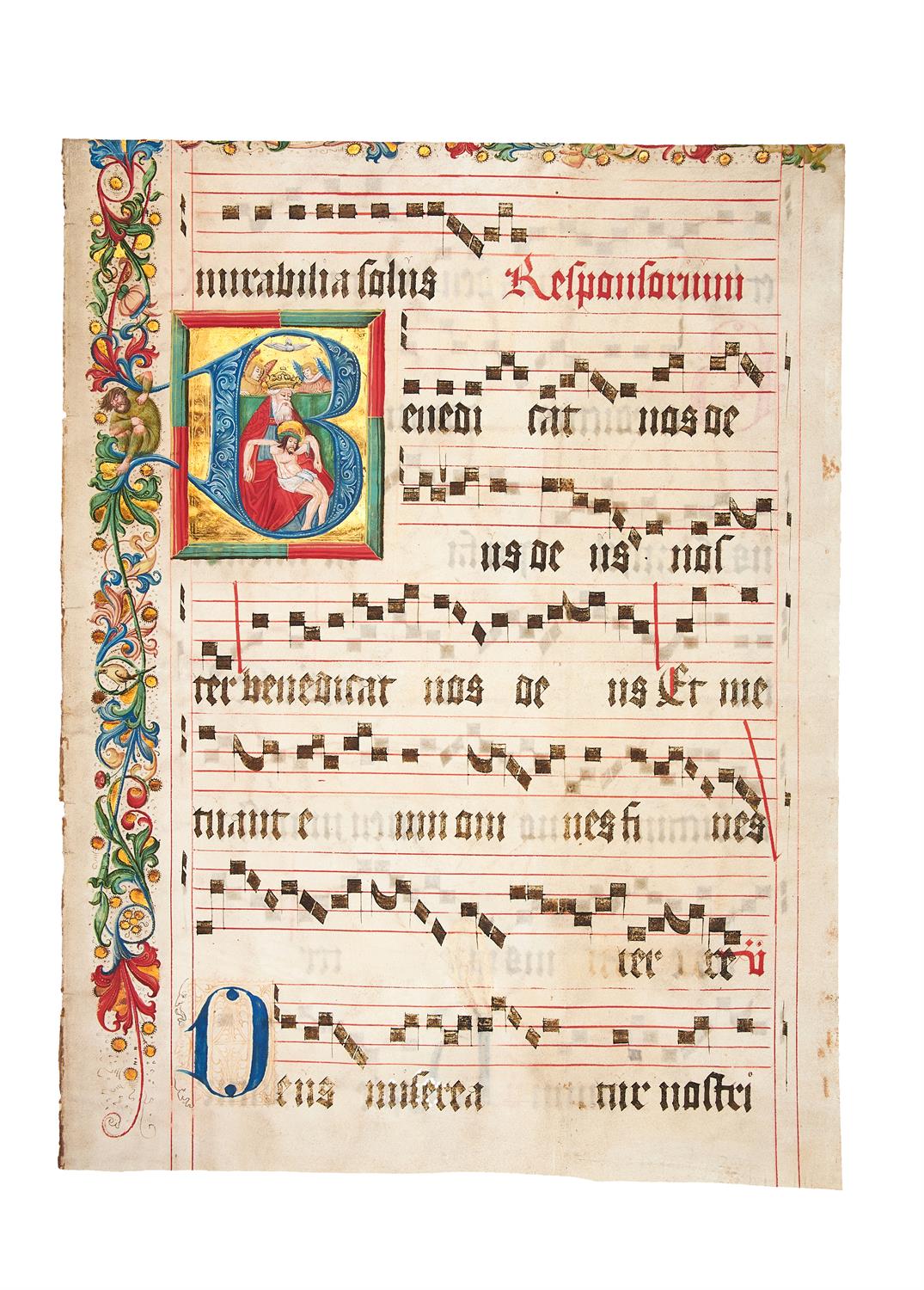TRINITY, historiated initial B, cutting from an ILLUMINATED MANUSCRIPT CHOIRBOOK ON VELLUM [Italy, Ferrara, c.1460] 160 x 160mm overall. Against a background of burnished gold, an initial B with staves of yellow-banded, stone-coloured balusters and cornucopia, swags of foliage and fruit, a three-faced cherub-head and acanthus terminals, and with a goldfinch perched to one side; the initial containing a 'Gnadenstuhl' Trinity against a mandorla composed of the heads and wings of seraphim and cherubim, God the Father supporting the cross with Christ crucified, the dove of the Holy Spirit issuing in rays from the mouth of the Father towards Christ's ear (slight abrasions to surface of gold, a few small losses of pigment mostly in acanthus of lower left and along a crease beside the upright of the B, a few offsets of red). This initial is likely to have opened the introit Benedicta sit sancta trinitas for Mass on Trinity Sunday, in a large-format choirbook Gradual. This splendid initial is the work of Taddeo Crivelli (Boskovits, 1978). Its rich combination of 'sculpted' renaissance forms and the stylised and realistic foliage demonstrate his authorship: all these elements, from the three-faced putto mask to the cornucopia, can be matched in the frontispieces he painted for the Bible of Borso d'Este (Modena, Bibl. Estense Universitaria Ms Lat. 422, V.G. 13, fols 26v and 280v). One of the most lavish princely commissions of the 15th century, the Bible was illuminated by a team of artists headed by Crivelli and Franco dei Russi from 1456 to 1461, but it was undoubtedly Crivelli who had the major role in the project. It was one of many manuscripts he undertook for the duke of Ferrara and members of his court, and Crivelli is justly regarded as one of the founders of the Ferrarese school of illumination. The central group of the Trinity, more highly finished and precisely painted than many of Crivelli's smaller-scale works, reveals the artist's contact with the work of one of his predecessors at the d'Este court. Belbello da Pavia (fl. 1430-after 1473) had illuminated the Bible of Niccolò III d'Este (Vatican, Biblioteca Apostolica, Ms Barb. lat. 613), Borso's father and marchese of Ferrara from 1393 to 1441. It has often been suggested that Borso ordered his own Bible as a response to his father's patronage, and the influence of the earlier manuscript has been recognised in Crivelli's frontispieces. The present initial shows a striking absorption of Belbello's style in the attenuated figures and the broad flowing drapery: the subtle, and unusual, combination of purple and blue robes and their borders of mock-kufic script seem a direct quotation from Belbello's representation of God the Father in Niccolò's Bible. There is another quotation from a work made for one of Borso's relatives: the three-faced putto mask repeats the reverse of one of Pisanello's medals for Leonello d'Este, Borso's elder brother. Taddeo Crivelli (fl. 1451-c. 1479) is known to have worked on choirbooks in Bologna, where he had moved after Borso's death. These commissions -- for San Procolo in 1473 and for San Petronio in 1476 -- ended badly, with Crivelli pawning the gatherings he was working on. He completed only five initials of the San Petronio manuscripts (Museo di San Petronio, Corali VI, 98). One of these (f. 58v) repeats the composition of the present Trinity but without any trace of the 'International style' elegance drawn from Belbello. The links with earlier d'Este commissions, in style and motif, suggest that the present sumptuous initial was painted when Taddeo Crivelli was at the peak of his career as the most highly valued illuminator at the d'Este court. M. Boskovits, 'Ferrarese painting about 1450: some new arguments', The Burlington Magazine , CXX, 1978, p.382, fig.33: identifying the present initial as by Crivelli and giving its location as 'Formerly Drey Collection, Munich'. La miniatura a Ferrara dal tempo di Cosmè Tura all'eredità di Er
TRINITY, historiated initial B, cutting from an ILLUMINATED MANUSCRIPT CHOIRBOOK ON VELLUM [Italy, Ferrara, c.1460] 160 x 160mm overall. Against a background of burnished gold, an initial B with staves of yellow-banded, stone-coloured balusters and cornucopia, swags of foliage and fruit, a three-faced cherub-head and acanthus terminals, and with a goldfinch perched to one side; the initial containing a 'Gnadenstuhl' Trinity against a mandorla composed of the heads and wings of seraphim and cherubim, God the Father supporting the cross with Christ crucified, the dove of the Holy Spirit issuing in rays from the mouth of the Father towards Christ's ear (slight abrasions to surface of gold, a few small losses of pigment mostly in acanthus of lower left and along a crease beside the upright of the B, a few offsets of red). This initial is likely to have opened the introit Benedicta sit sancta trinitas for Mass on Trinity Sunday, in a large-format choirbook Gradual. This splendid initial is the work of Taddeo Crivelli (Boskovits, 1978). Its rich combination of 'sculpted' renaissance forms and the stylised and realistic foliage demonstrate his authorship: all these elements, from the three-faced putto mask to the cornucopia, can be matched in the frontispieces he painted for the Bible of Borso d'Este (Modena, Bibl. Estense Universitaria Ms Lat. 422, V.G. 13, fols 26v and 280v). One of the most lavish princely commissions of the 15th century, the Bible was illuminated by a team of artists headed by Crivelli and Franco dei Russi from 1456 to 1461, but it was undoubtedly Crivelli who had the major role in the project. It was one of many manuscripts he undertook for the duke of Ferrara and members of his court, and Crivelli is justly regarded as one of the founders of the Ferrarese school of illumination. The central group of the Trinity, more highly finished and precisely painted than many of Crivelli's smaller-scale works, reveals the artist's contact with the work of one of his predecessors at the d'Este court. Belbello da Pavia (fl. 1430-after 1473) had illuminated the Bible of Niccolò III d'Este (Vatican, Biblioteca Apostolica, Ms Barb. lat. 613), Borso's father and marchese of Ferrara from 1393 to 1441. It has often been suggested that Borso ordered his own Bible as a response to his father's patronage, and the influence of the earlier manuscript has been recognised in Crivelli's frontispieces. The present initial shows a striking absorption of Belbello's style in the attenuated figures and the broad flowing drapery: the subtle, and unusual, combination of purple and blue robes and their borders of mock-kufic script seem a direct quotation from Belbello's representation of God the Father in Niccolò's Bible. There is another quotation from a work made for one of Borso's relatives: the three-faced putto mask repeats the reverse of one of Pisanello's medals for Leonello d'Este, Borso's elder brother. Taddeo Crivelli (fl. 1451-c. 1479) is known to have worked on choirbooks in Bologna, where he had moved after Borso's death. These commissions -- for San Procolo in 1473 and for San Petronio in 1476 -- ended badly, with Crivelli pawning the gatherings he was working on. He completed only five initials of the San Petronio manuscripts (Museo di San Petronio, Corali VI, 98). One of these (f. 58v) repeats the composition of the present Trinity but without any trace of the 'International style' elegance drawn from Belbello. The links with earlier d'Este commissions, in style and motif, suggest that the present sumptuous initial was painted when Taddeo Crivelli was at the peak of his career as the most highly valued illuminator at the d'Este court. M. Boskovits, 'Ferrarese painting about 1450: some new arguments', The Burlington Magazine , CXX, 1978, p.382, fig.33: identifying the present initial as by Crivelli and giving its location as 'Formerly Drey Collection, Munich'. La miniatura a Ferrara dal tempo di Cosmè Tura all'eredità di Er







.jpg)

.jpg)



.jpg)
Testen Sie LotSearch und seine Premium-Features 7 Tage - ohne Kosten!
Lassen Sie sich automatisch über neue Objekte in kommenden Auktionen benachrichtigen.
Suchauftrag anlegen